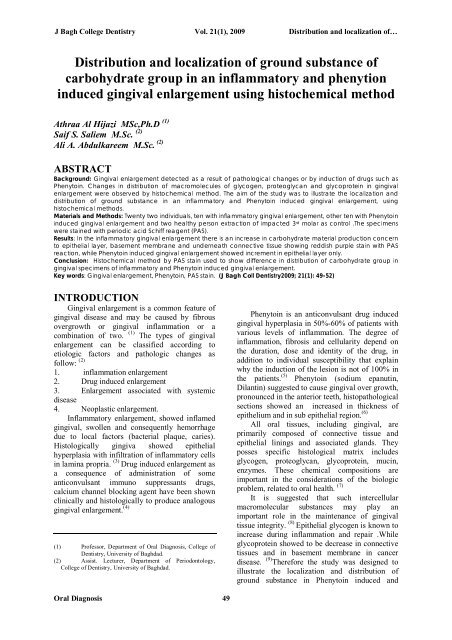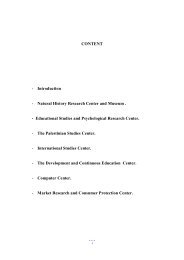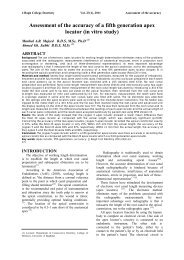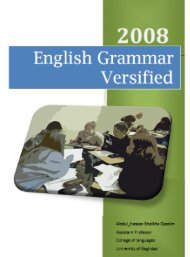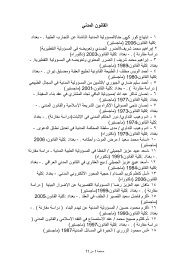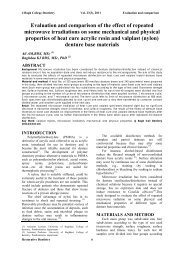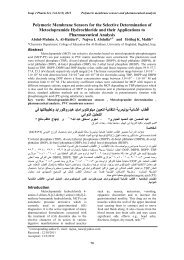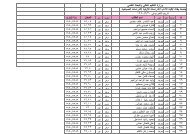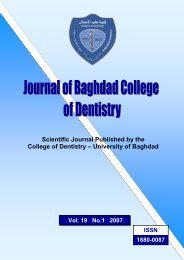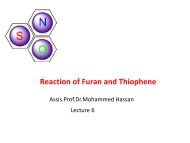Vol 21 No. 1
Vol 21 No. 1
Vol 21 No. 1
Create successful ePaper yourself
Turn your PDF publications into a flip-book with our unique Google optimized e-Paper software.
J Bagh College Dentistry <strong>Vol</strong>. <strong>21</strong>(1), 2009 Distribution and localization of…<br />
Distribution and localization of ground substance of<br />
carbohydrate group in an inflammatory and phenytion<br />
induced gingival enlargement using histochemical method<br />
Athraa Al Hijazi MSc,Ph.D (1)<br />
Saif S. Saliem M.Sc. (2)<br />
Ali A. Abdulkareem M.Sc. (2)<br />
ABSTRACT<br />
Background: Gingival enlargement detected as a result of pathological changes or by induction of drugs such as<br />
Phenytoin. Changes in distribution of macromolecules of glycogen, proteoglycan and glycoprotein in gingival<br />
enlargement were observed by histochemical method. The aim of the study was to illustrate the localization and<br />
distribution of ground substance in an inflammatory and Phenytoin induced gingival enlargement, using<br />
histochemical methods.<br />
Materials and Methods: Twenty two individuals, ten with inflammatory gingival enlargement, other ten with Phenytoin<br />
induced gingival enlargement and two healthy person extraction of impacted 3 rd molar as control .The specimens<br />
were stained with periodic acid Schiff reagent (PAS).<br />
Results: In the inflammatory gingival enlargement there is an increase in carbohydrate material production concern<br />
to epithelial layer, basement membrane and underneath connective tissue showing reddish purple stain with PAS<br />
reaction, while Phenytoin induced gingival enlargement showed increment in epithelial layer only.<br />
Conclusion: Histochemical method by PAS stain used to show difference in distribution of carbohydrate group in<br />
gingival specimens of inflammatory and Phenytoin induced gingival enlargement.<br />
Key words: Gingival enlargement, Phenytoin, PAS stain. (J Bagh Coll Dentistry2009; <strong>21</strong>(1): 49-52)<br />
INTRODUCTION<br />
Gingival enlargement is a common feature of<br />
gingival disease and may be caused by fibrous<br />
overgrowth or gingival inflammation or a<br />
combination of two. (1) The types of gingival<br />
enlargement can be classified according to<br />
etiologic factors and pathologic changes as<br />
follow: (2)<br />
1. inflammation enlargement<br />
2. Drug induced enlargement<br />
3. Enlargement associated with systemic<br />
disease<br />
4. Neoplastic enlargement.<br />
Inflammatory enlargement, showed inflamed<br />
gingival, swollen and consequently hemorrhage<br />
due to local factors (bacterial plaque, caries).<br />
Histologically gingiva showed epithelial<br />
hyperplasia with infiltration of inflammatory cells<br />
in lamina propria. (3) Drug induced enlargement as<br />
a consequence of administration of some<br />
anticonvulsant immuno suppressants drugs,<br />
calcium channel blocking agent have been shown<br />
clinically and histologically to produce analogous<br />
gingival enlargement. (4)<br />
(1) Professor, Department of Oral Diagnosis, College of<br />
Dentistry, University of Baghdad.<br />
(2) Assist. Lecturer, Department of Periodontology,<br />
College of Dentistry, University of Baghdad.<br />
Phenytoin is an anticonvulsant drug induced<br />
gingival hyperplasia in 50%-60% of patients with<br />
various levels of inflammation. The degree of<br />
inflammation, fibrosis and cellularity depend on<br />
the duration, dose and identity of the drug, in<br />
addition to individual susceptibility that explain<br />
why the induction of the lesion is not of 100% in<br />
the patients. (5) Phenytoin (sodium epanutin,<br />
Dilantin) suggested to cause gingival over growth,<br />
pronounced in the anterior teeth, histopathological<br />
sections showed an increased in thickness of<br />
epithelium and in sub epithelial region. (6)<br />
All oral tissues, including gingival, are<br />
primarily composed of connective tissue and<br />
epithelial linings and associated glands. They<br />
posses specific histological matrix includes<br />
glycogen, proteoglycan, glycoprotein, mucin,<br />
enzymes. These chemical compositions are<br />
important in the considerations of the biologic<br />
problem, related to oral health. (7)<br />
It is suggested that such intercellular<br />
macromolecular substances may play an<br />
important role in the maintenance of gingival<br />
tissue integrity. (8) Epithelial glycogen is known to<br />
increase during inflammation and repair .While<br />
glycoprotein showed to be decrease in connective<br />
tissues and in basement membrane in cancer<br />
disease. (9) Therefore the study was designed to<br />
illustrate the localization and distribution of<br />
ground substance in Phenytoin induced and<br />
Oral Diagnosis 49


